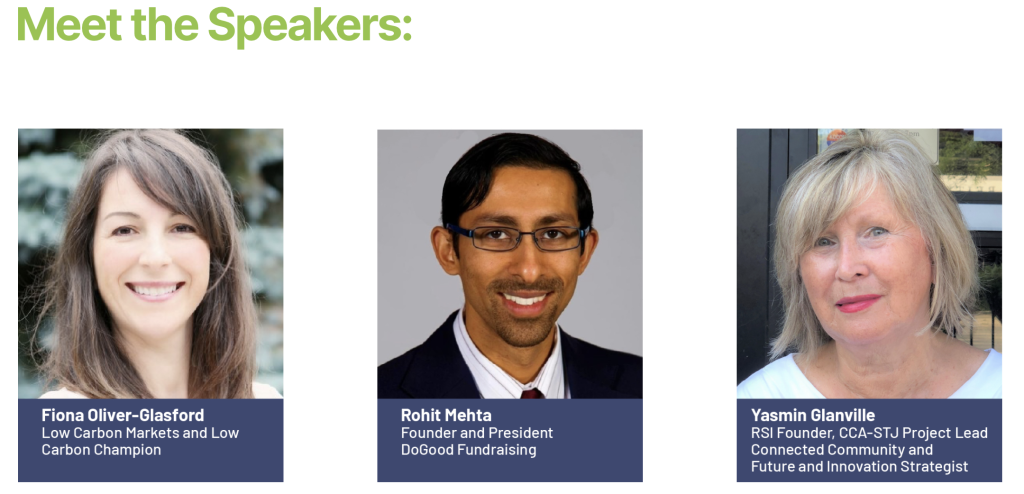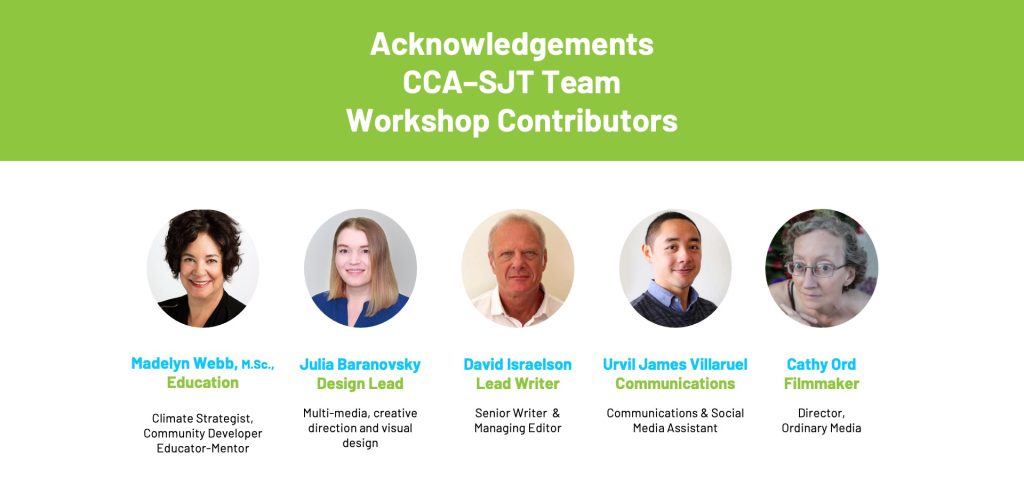On December 9th, 2021 RSI hosted a workshop on funding and support for climate and community resiliency solutions being developed as part of Community Climate Action in St. James Town (SJT).
Getting projects off the ground takes work. We heard from experienced experts and finished with an open forum.

Yasmin Glanville, RSI Founder and CCA-SJT Project Lead introduced the topic by encouraging project leaders to define their proposal and connect it to the potential funder.
Keys to Stakeholder Engagement
- Who needs to be engaged? Why and how?
- What are the potential stakeholders interested in? What do they want?
- What’s the best way to work together?
- What’s your engagement strategy. What do the stakeholders already have in place?
- Do you have shared values? Build your relationship on these, and trust.
- Consult early and consult often.

Tips to communicate and connect with stakeholders
- Use a shared experience
- Include people who represent the community
- Don’t talk down to people.
- Adapt your message to your audience.
- Tailor your message — hat we have to sell and how we sell it might not connect with everyone
- Listen
- Visual storytelling is important. Keep it simple; make it positive; make it beautiful; show, don’t tell
- Check-in and re-evaluate often. Is what we’re doing working? If not, what needs to change? Be prepared to adapt.
- Ask if we’re the right people to be speaking to? Should we bring other people in?

Refining Your Approach
Fiona Oliver-Glasford, Low Carbon Markets and Low Carbon Champion offered tips on refining your approach and relating to your audience.
When you define your goal precisely, neither too narrow nor too wide), you’ll discover that you can’t tackle everything at once. Figure out the main barriers. Be clear if you are ready to launch or still in development. Fiona suggests listing and ranking all the tasks you have ahead, to determine what to tackle first.

Once you have created a prototype, you’ll need to figure out who to market to. Create an audience profile that includes where they get information and how they want to be reached.
Gauge prospective supporters’ engagement
- Do they care?
- Are they friendly or hostile?
- What’s their awareness level?

Getting movement on engagement:
- Connect with your audience.
- Ensure they understand why the outcome matters to them
- Identify a call to action. How do people get involved? What do you want them to do?
- If converting someone from hostile to friendly:
- Look for a strong touchpoint.
- Build trust and understanding by meeting them in person
- Partner with respected research groups, or academic institutions for credibility
- There’s no shame in admitting you don’t have an answer.
- Be patient, respectful and consistent
- Get third-party experts to support your work and communicate at your audience’s level.
Applying for Funding
Rohit Mehta, Founder and President, DoGood Fundraising
Rohit focused on applying for grants.
- Core or Operations Grants
- Harder to come by
- Can be used for administrative purchases
- Seed or Pilot Funding
- One-time grant or funding
- Most often funded by foundations such as Trillium
- Expert tip: funders will fund multiple phases, so break your project into phases instead of asking for the whole grant at once
- Program or Project Funding
- The most common type of funding
- Needs tangible results and identifiable outcomes
- Has a defined start and end date
- Sources: corporations, foundations and governments
- Capacity Building Funding
- Training-related grants
- Appropriate for anything that relates to learning, training and coaching
- If you have training to share, a lot of funders will pay you to help non-profits
- Capital and equipment funding
- Renovations, repairs, making a space COVID friendly, upgrading technological resources
- Sources: most often funded by foundations
- Deficit Funding
- Funders will give you money to cover shortfalls
- Sources: most often foundations
- In-kind Donations
- Goods or services
- Repairs
- Web Maintenance or Graphic Design
Expert tip: if you need to pay your Executive Director, you can put multiple grants together and pull from different sources to do so (ex: $15k from an operations grant, $15k from seed funding, etc.)
Rohit shared that we should be selective when looking for funding and stay on course. Seekers should plan ahead to be ready to jump on grants when they come out.

Funders who give grants: Corporations, Foundations, Government
- Corporations
- These grant proposals are easy to write.
- Can require employee buy-in.
- They want a charitable tax receipt.
- They fund projects to receive a benefit.
- Foundations
- Appreciate recognition, but don’t base funding decisions on this.
- Some will give money as corporate social responsibility (CSR).
- Will want recognition metrics (likes, reach, etc.).
- Government
- Most challenging type of funding to get, but is transparent.
- Helps to know people in politics and government because they can help move things along.

If you’re submitting a proposal, you’ll want to ensure you include:
- The problem, summary, goals, objectives, and how you expect to achieve results,
- Answers to: “What will you do after we fund you?” and “What’s your plan to be self-sufficient after?”
Common Mistakes in Grant Writing
- Starting from scratch with each
- Have a collection of key elements that all grants will ask for to make the proposal process easier
- No commitment to long-term projects
- You need to have a goal, don’t just ask for money
- Have a mission and stick to it
- Long-term goals will receive more investments and more long-term support, it’s mostly governments that focus on short-term
- Corporations will work faster to give you grants and grants will be easier
- Spelling and grammar
- Double-check your entire proposal!
- Too much jargon
- Reviewers need to “get it” — focus on the funder’s language
- Don’t assume familiarity with things like acronyms – spell them out at least once.
- Funders are regular people just like us!
- MAKE SURE you answer the question associated with the grant
- Some people will fill pages with data, but not answer the question
- Answer the question in your first sentence and support that with data if you need to
Open Forum Q&A
The open discussion provided several additional tips or elaborations on speakers’ thoughts.
How can you narrow down thousands of possible grants as a non-profit?
Engage a prospect researcher to seek out grants. They can use search tools to match your funders with your project.
How do you go about asking for funding for a homelessness program?
- Seek out energy companies; they have a high desire to help.
- Projects looking to make a systems change need to ensure the solution is appropriate.
- Do a needs assessment
- To challenge bureaucracy, create your own system.
- Corporations want a breakdown of data to support your solution.
- Collect and keep your data – it will help you apply for other grants.
Any advice on starting a non-profit in schools surrounding mental health resilience?
- Be clear on why and how you’re doing this.
- Why is your resilience solution going to work?
- Don’t just do good work, be seen doing it.
- Show your broader community that you’re doing the work.
- Be ready for opportunities and ready to demonstrate. For example, Trillium will ask you to see what you’re doing so far.
- Create legitimacy by building a presence online and in the community: this really helps push governments, corporations, etc.
- Create a bank account, incorporate, do a first fundraiser.
- Find someone who believes in you:
- Have the courage to call people.
- Reach out to mentors – a lot of them have similar causes or passions they’re looking to support.
Are there opportunities to work with companies regarding performance-based funding?
Pay for performance is growing in popularity now. If you can achieve your outcome, funders get a percentage of the proceeds; making a profit from their investment. This is controversial now.
What is your advice for someone to present the best strategy? How do I be proactive in helping to get the right grants?
Email Rohit for help. Let your passion shine!
How do you grow your business on a small budget?
Build relationships. You will get referral calls by doing good work
Additional Closing Tips
- Find case studies, gather testimonials, connect with experts.
- Form relationships and build a circle of trust.
Key Takeaways
Fiona’s biggest takeaway: the wealth of talent and passion to move the dial on environmental issues comes from people within St. James Town.
She said that Yasmin and the RSI team hosted a thoughtful, focused session that drew an enthusiastic and engaged crowd. Participants want to move their ESG initiatives and their careers forward.
Rohit’s follow-up advice is don’t be too rigid in your plans when working on impactful projects and there’s a lot of expertise and experience in the room – talk often!

What a Team!
Thank you again to the CCA-SJT for creating a year full of great workshops and building such promising momentum.

